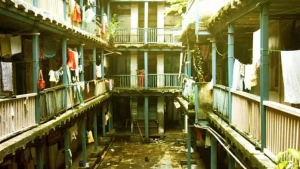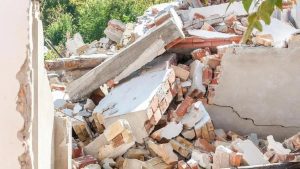The early hours of Friday morning brought devastating news as a Mumbai chawl collapse incident left 15 people injured in the Bharat Nagar area of Bandra East. The three-storey residential structure partially collapsed around 7:50 AM, creating panic among residents and triggering an immediate emergency response from local authorities.
According to eyewitness accounts and preliminary investigations, Mumbai Fire Brigade officials suspect that a cylinder blast may have been the primary cause behind this tragic Mumbai chawl collapse. The incident has highlighted ongoing safety concerns regarding old residential structures and gas cylinder storage in Mumbai’s densely populated areas.
View this post on Instagram
The moment news of the Mumbai chawl collapse reached emergency services, multiple rescue teams were deployed to the scene. Mumbai Fire Brigade personnel, along with local police and emergency medical services, launched an extensive search and rescue operation to locate and assist victims trapped under the debris.
Initial reports confirmed that 12 people were successfully rescued from the collapsed structure, while several others sustained injuries of varying severity. The coordinated rescue effort involved specialised equipment and trained personnel working tirelessly to ensure no one remained trapped beneath the rubble following the Mumbai chawl collapse.
Emergency services established a perimeter around the affected area, evacuating nearby residents as a precautionary measure. The swift response prevented what could have been a more devastating outcome, though the incident serves as a stark reminder of the vulnerability of ageing residential structures in Mumbai.
Preliminary investigations into the Mumbai chawl collapse have focused on the possibility of a gas cylinder explosion as the trigger for the structural failure. Mumbai Police officials, working in conjunction with the IRE department investigators, are examining the sequence of events that led to this tragic incident.
Eyewitness testimonies suggest that residents heard a loud explosion shortly before portions of the building began to collapse. The force of the suspected cylinder blast appears to have compromised the structural integrity of the three-storey chawl, causing sections of the building to crumble and trapping residents inside.
Fire department officials are conducting a thorough examination of the premises to determine the exact cause of the Mumbai chawl collapse. The investigation will include analysis of gas connections, cylinder storage practices, and overall structural conditions that may have contributed to the incident.
 Mumbai chawl collapse
Mumbai chawl collapse
has sent shockwaves through the local community in Bharat Nagar, where such residential structures house hundreds of families nearby. Chawls, which are traditional tenement buildings, serve as affordable housing for Mumbai’s working-class population but often lack modern safety features.
Residents of nearby chawls have expressed concern about the safety of their buildings, many of which are decades old and may have similar structural vulnerabilities. The incident has prompted discussions about the need for regular safety inspections and updated building codes for older residential structures.
Local authorities have assured residents that immediate assessments of similar structures in the area will be conducted to prevent future incidents. The Mumbai chawl collapse has brought attention to the broader issue of housing safety in Mumbai’s older residential areas.
Following the Mumbai chawl collapse, injured victims were immediately transported to nearby hospitals for medical treatment. Emergency medical teams worked efficiently to provide first aid at the scene before transferring patients to appropriate medical facilities based on the severity of their injuries.
Hospital authorities confirmed that among the 15 injured individuals, most sustained injuries from falling debris and structural elements. Medical professionals are monitoring the condition of all patients, with some requiring surgery for fractures and other serious injuries sustained during the Mumbai chawl collapse.
The quick medical response helped minimise the severity of injuries and prevented any immediate fatalities, though the long-term impact on victims’ health and livelihoods remains a concern for local authorities and community leaders.
The Mumbai chawl collapse has reignited debates about the safety of ageing residential structures throughout the city. Many of Mumbai’s chawls were constructed decades ago using building standards that may not meet current safety requirements, particularly regarding gas installation and structural integrity.
Urban planning experts have long warned about the risks associated with old residential buildings in Mumbai, where space constraints and economic factors often lead to compromises in safety standards. The recent Mumbai chawl collapse serves as a tragic reminder of these ongoing concerns.
City authorities are now under pressure to implement comprehensive safety audits of similar structures and establish stricter guidelines for gas cylinder storage and usage in residential buildings. The incident has also prompted calls for better emergency preparedness in densely populated areas.


The Mumbai Fire Brigade is planning to conduct safety awareness campaigns in chawl areas, educating residents about proper gas cylinder handling and emergency response procedures. These initiatives aim to prevent similar incidents and ensure that residents are prepared to respond effectively in case of emergencies.
Building owners and housing societies are being encouraged to conduct regular safety assessments and implement necessary upgrades to prevent future occurrences similar to the Mumbai chawl collapse. The tragic incident has become a catalyst for broader discussions about residential safety in Mumbai.
The Mumbai chawl collapse in Bandra East serves as a sobering reminder of the importance of residential safety and proper maintenance of ageing structures. While the immediate focus remains on supporting the injured victims and their families, the incident has highlighted the urgent need for comprehensive safety measures in Mumbai’s older residential areas.
As investigations continue and recovery efforts proceed, the lessons learned from this tragic Mumbai chawl collapse must be applied to prevent similar incidents in the future. The safety of Mumbai’s residents depends on collective efforts from authorities, building owners, and communities to ensure that proper safety standards are maintained and enforced across all residential structures.

